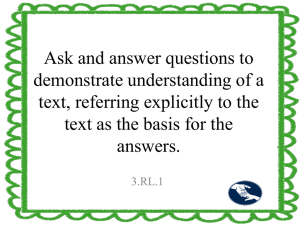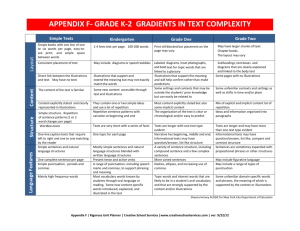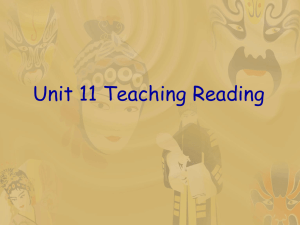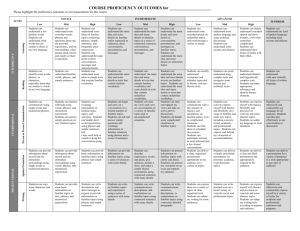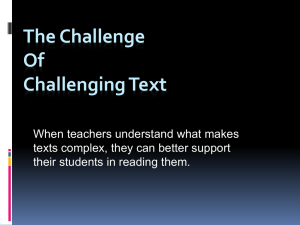English Language Arts Standards- Literature (Picture Books
advertisement
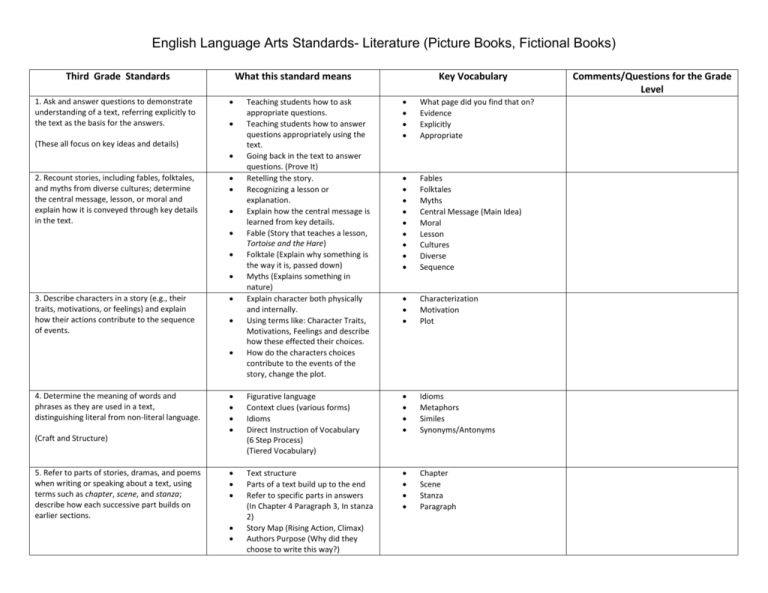
English Language Arts Standards- Literature (Picture Books, Fictional Books) Third Grade Standards 1. Ask and answer questions to demonstrate understanding of a text, referring explicitly to the text as the basis for the answers. What this standard means Teaching students how to ask appropriate questions. Teaching students how to answer questions appropriately using the text. Going back in the text to answer questions. (Prove It) Retelling the story. Recognizing a lesson or explanation. Explain how the central message is learned from key details. Fable (Story that teaches a lesson, Tortoise and the Hare) Folktale (Explain why something is the way it is, passed down) Myths (Explains something in nature) Explain character both physically and internally. Using terms like: Character Traits, Motivations, Feelings and describe how these effected their choices. How do the characters choices contribute to the events of the story, change the plot. What page did you find that on? Evidence Explicitly Appropriate Fables Folktales Myths Central Message (Main Idea) Moral Lesson Cultures Diverse Sequence Characterization Motivation Plot Figurative language Context clues (various forms) Idioms Direct Instruction of Vocabulary (6 Step Process) (Tiered Vocabulary) Idioms Metaphors Similes Synonyms/Antonyms Text structure Parts of a text build up to the end Refer to specific parts in answers (In Chapter 4 Paragraph 3, In stanza 2) Story Map (Rising Action, Climax) Authors Purpose (Why did they choose to write this way?) Chapter Scene Stanza Paragraph (These all focus on key ideas and details) 2. Recount stories, including fables, folktales, and myths from diverse cultures; determine the central message, lesson, or moral and explain how it is conveyed through key details in the text. 3. Describe characters in a story (e.g., their traits, motivations, or feelings) and explain how their actions contribute to the sequence of events. 4. Determine the meaning of words and phrases as they are used in a text, distinguishing literal from non-literal language. (Craft and Structure) 5. Refer to parts of stories, dramas, and poems when writing or speaking about a text, using terms such as chapter, scene, and stanza; describe how each successive part builds on earlier sections. Key Vocabulary Comments/Questions for the Grade Level 6. Distinguish their own point of view from that of the narrator or those of the characters. 7. Explain how specific aspects of a text’s illustrations contribute to what is conveyed by the words in a story (e.g., create mood, emphasize aspects of a character or setting). (Integration of Knowledge and Ideas) Authors Purpose (why their writing the story) Authors Point of View (their opinion of the topic) Identify their own point of view Persuasive Pieces good for this Author tells the story through words Illustrator tells the story through pictures, drawings, photographs, etc. Read a picture book without pictures or a picture book without words. Read similar stories but look at the way the illustrators change the meaning. The way illustrations enhance the words, point of specific details, etc. Point of view Purpose Author Illustrator Mood Illustrations Compare and Contrast stories on the same topic or from similar stories. Magic Tree House/Junie B. Jones/ Venn Diagrams Compare Plot structures, Compare character traits, setting, do character evolve throughout series Read independently at (_______) by the end of the year. Compare (Similar) Contrast (Difference) Themes (overall mood for story) (Decorations) Plot (Structure) (House) 8. (Not applicable to literature) 9. Compare and contrast the themes, settings, and plots of stories written by the same author about the same or similar characters (e.g., in books from a series). 10. By the end of the year read and comprehend literature, including stories, dramas, and poetry, at the high end of the grades 2–3 text complexity band independently and proficiently. (Range of Reading and Level of text complexity) 11. Recognize and make connections in narratives, poetry, and drama to other texts, ideas, cultural perspectives, personal events, and situations. a. Self-select text based upon personal preferences. (NYS Standard) (Responding to Literature) Text to Self, Text to Text, Text to World. Making connections that help comprehension. (The how and the why, not just the what) Does the connection help you understand the character/motivations/etc. What are the requirements for end of year independent reading levels? English Language Arts Standards- Informational Text Third Grade Standards 1. Ask and answer questions to demonstrate understanding of a text, referring explicitly to the text as the basis for the answers. What this standard Means Key Vocabulary Teaching students how to ask appropriate questions. Teaching students how to answer questions appropriately using the text. Going back in the text to answer questions. (Prove It) Determine what the main idea is Find supporting details Explain how the supporting details lead to the main idea or support it Move from key details to main idea Sequencing Steps in a process Cause/Effect relationships Identify how life would be different without a step What page did you find that on? Evidence Explicitly Appropriate Supporting details Key details Transitional Words Cause/Effect Time ordered words Recognize the difference between general words and subject specific words for their topic. Context clues Bolded Italicized Phonetic spelling 5. Use text features and search tools (e.g., key words, sidebars, hyperlinks) to locate information relevant to a given topic efficiently. Electronic and print text Glossary, Index, caption, hyperlink, sidebars, illustration 6. Distinguish their own point of view from that of the author of a text. Identify authors point of view in an informational text Editorial, video Exposure to multiple texts on the same topic and asking them to explain which they agree with and why ( Key Ideas and Details) 2. Determine the main idea of a text; recount the key details and explain how they support the main idea. 3. Describe the relationship between a series of historical events, scientific ideas or concepts, or steps in technical procedures in a text, using language that pertains to time, sequence, and cause/effect. 4. Determine the meaning of general academic and domain specific words and phrases in a text relevant to a grade 3 topic or subject area. (Craft and Structure) Grade Level Comments/Questions 7. Use information gained from illustrations (e.g., maps, photographs) and the words in a text to demonstrate understanding of the text (e.g., where, when, why, and how key events occur). (Integration on Knowledge and Ideas) 8. Describe the logical connection between particular sentences and paragraphs in a text (e.g., comparison, cause/effect, first/second/third in a sequence). 9. Compare and contrast the most important points and key details presented in two texts on the same topic. Using maps and photographs to answer 5W questions. Illustrations are put there for a reason Maps Timelines Identifying why the author sets up the text the way they do Sequencing Cause and effect Connections between sentences and paragraphs. Identify the most important points Pull out key details from two texts on the same topic. Compare and contrast the most important points Similar topics with different types of illustrations. Time order words 10. By the end of the year, read and comprehend informational texts, including history/social studies, science, and technical texts, at the high end of the grades 2–3 text complexity band independently and proficiently. (Range of Reading and text complexity) English Language Arts Standards- Foundational Skills Third Grade Standards Phonics and Word Recognition 3. Know and apply grade-level phonics and word analysis skills in decoding words. a. Identify and know the meaning of the most common prefixes and derivational suffixes. b. Decode words with common Latin suffixes. c. Decode multi-syllable words. d. Read grade-appropriate irregularly spelled words. What the Standard Means Prefixes (un- dis- pre- re- mis-) Derivational Suffix (-ly –er –ing –or –able –fy –ical –ed –est –ful –ist) Syllable (each syllable has a vowel) Irregularly (There, Their, They’re, to, too, two) Grade Level Comments/Questions Fluency 4. Read with sufficient accuracy and fluency to support comprehension. a. Read grade-level text with purpose and understanding. b. Read grade-level prose and poetry orally with accuracy, appropriate rate, and expression on successive readings. c. Use context to confirm or self-correct word recognition and understanding, rereading as necessary. Reading for comprehension and accuracy. Writing Standards Third Grade Standards 1. Write opinion pieces on topics or texts, supporting a point of view with reasons. a. Introduce the topic or text they are writing about, state an opinion, and create an organizational structure that lists reasons. b. Provide reasons that support the opinion. c. Use linking words and phrases (e.g., because, therefore, since, for example) to connect opinion and reasons. d. Provide a concluding statement or section. (Text Types and Purposes) 2. Write informative/explanatory texts to examine a topic and convey ideas and information clearly. a. Introduce a topic and group related information together; include illustrations when useful to aiding comprehension. b. Develop the topic with facts, definitions, and details. c. Use linking words and phrases (e.g., also, another, and, more, but) to connect ideas within categories of information. d. Provide a concluding statement or section What the Standard Means Topic Sentence State Opinion List Reasons (structured) Use linking words to connect opnion to reasons (therefore, etc.) Concluding Sentence Identify Topic Add facts and details Use linking words Provide a concluding sentence Grade Level Comments/Questions 3. Write narratives to develop real or imagined experiences or events using effective technique, descriptive details, and clear event sequences. a. Establish a situation and introduce a narrator and/or characters; organize an event sequence that unfolds naturally. b. Use dialogue and descriptions of actions, thoughts, and feelings to develop experiences and events or show the response of characters to situations. c. Use temporal words and phrases to signal event order. d. Provide a sense of closure. 4. With guidance and support from adults, produce writing in which the development and organization are appropriate to task and purpose. (Grade-specific expectations for writing types are defined in standards 1–3 above.) (Production and Distribution of Writing) Identify a topic Use dialogue and descriptions Sequence Provide closure Record a student conversation and then have them listen and write it down. Add the quotation marks and the she said he said. Writing matches the purpose Paper is organized in a way that makes sense for the purpose Content organization (paragraph, stanza, scenes) Whole Group instruction (modeling with think aouds) Conferencing Referring them to charts, anchor papers Using mentor texts , read alouds with purposeful attention to writing. Model peer editing (Fish bowl) have two students peer edit in the center of the students with them sitting around and model what peer editing is. Not just editing but also commenting on revising. 5. With guidance and support from peers and adults, develop and strengthen writing as needed by planning, revising, and editing. (Editing for conventions should demonstrate command of Language standards 1–3 up to and including grade 3 on page 29.) 6. With guidance and support from adults, use technology to produce and publish writing (using keyboarding skills) as well as to interact and collaborate with others. Typing skills Producing is typing a final piece on the computer Publishing would be sharing with others E-mailing letters back and forth (Pen Pal) Upload to WikiSpaces, online board?? 7. Conduct short research projects that build knowledge about a topic. (Research) Independently research Books and On-Line More than 1 From both print and digital sources 8. Recall information from experiences or gather information from print and digital sources; take brief notes on sources and sort evidence into provided categories. Take notes from sources Sort evidence into categories from research Process of researching Writing process Timed writing pieces 9. (Begins in grade 4) 10. Write routinely over extended time frames (time for research, reflection, and revision) and shorter time frames (a single sitting or a day or two) for a range of discipline specific tasks, purposes, and audiences. (Range of Writing) 11. Create and present a poem, narrative, play, art work, or personal response to a particular author or theme studied in class. (NYS ADDITION) Create writing Present that writing Speaking and Listening Standards Third Grade Standards What the Standard Means Staying on topic Appropriate time to speak Taking turns Making eye contact Building on each other’s ideas Questioning the speaker (to get details) Having something ready to discuss Explicitly teach conversation etiquette Summarize the previous conversation at the beginning of yours (When you said……it reminded me of) Information read aloud, audio, video 3. Ask and answer questions about information from a speaker, offering appropriate elaboration and detail. Asking appropriate questions 4. Report on a topic or text, tell a story, or recount an experience with appropriate facts and relevant, descriptive details, speaking clearly at an understandable pace. Talk about appropriate volume and not covering face during presentation Record students reading Students need to create the audio file Doesn’t necessarily need to be their writing 1. Engage effectively in a range of collaborative discussions (one-onone, in groups, and teacher-led) with diverse partners on grade 3 topics and texts, building on others’ ideas and expressing their own clearly. a. Come to discussions prepared, having read or studied required material; explicitly draw on that preparation and other information known about the topic to explore ideas under discussion. b. Follow agreed-upon rules for discussions (e.g., gaining the floor in respectful ways, listening to others with care, speaking one at a time about the topics and texts under discussion). c. Ask questions to check understanding of information presented, stay on topic, and link their comments to the remarks of others. d. Explain their own ideas and understanding in light of the discussion. e. Seek to understand and communicate with individuals from different cultural backgrounds (Comprehension and Collaboration) 2. Determine the main ideas and supporting details of a text read aloud or information presented in diverse media and formats, including visually, quantitatively, and orally. (Presentation and Knowledge of Ideas) 5. Create engaging audio recordings of stories or poems that demonstrate fluid reading at an understandable pace; add visual displays when appropriate to emphasize or enhance certain facts or details. Grade Level Comments/Questions 6. Speak in complete sentences when appropriate to task and situation in order to provide requested detail or clarification. (See grade 3 Language standards 1 and 3 on page 26 for specific expectations.) When presenting, answer questions from audience with complete sentences. No longer accepting just yes and no questions. Language Standards Third Grade Standards 1. Demonstrate command of the conventions of standard English grammar and usage when writing or speaking. a. Explain the function of nouns, pronouns, verbs, adjectives, and adverbs in general and their functions in particular sentences. b. Form and use regular and irregular plural nouns. c. Use abstract nouns (e.g., childhood). d. Form and use regular and irregular verbs. e. Form and use the simple (e.g., I walked; I walk; I will walk) verb tenses. f. Ensure subject-verb and pronoun-antecedent agreement.* g. Form and use comparative and superlative adjectives and adverbs, and choose between them depending on what is to be modified. h. Use coordinating and subordinating conjunctions. i. Produce simple, compound, and complex sentences. 2. Demonstrate command of the conventions of standard English capitalization, punctuation, and spelling when writing. a. Capitalize appropriate words in titles. b. Use commas in addresses. c. Use commas and quotation marks in dialogue. d. Form and use possessives. e. Use conventional spelling for high-frequency and other studied words and for adding suffixes to base words (e.g., sitting, smiled, cries, happiness). f. Use spelling patterns and generalizations (e.g., word families, position-based spellings, syllable patterns, ending rules, meaningful word parts) in writing words. g. Consult reference materials, including beginning dictionaries, as needed to check and correct spellings. 3. Use knowledge of language and its conventions when writing, speaking, reading, or listening. a. Choose words and phrases for effect.* What the Standard Means Grade Level Comments/Questions b. Recognize and observe differences between the conventions of spoken and written standard English. 4. Determine or clarify the meaning of unknown and multiple-meaning word and phrases based on grade 3 reading and content, choosing flexibly from a range of strategies. a. Use sentence-level context as a clue to the meaning of a word or phrase. b. Determine the meaning of the new word formed when a known affix is added to a known word (e.g., agreeable/disagreeable, comfortable/uncomfortable, care/careless, heat/preheat). c. Use a known root word as a clue to the meaning of an unknown word with the same root (e.g., company, companion). d. Use glossaries or beginning dictionaries, both print and digital, to determine or clarify the precise meaning of key words and phrases. 5. Demonstrate understanding of word relationships and nuances in word meanings. a. Distinguish the literal and non-literal meanings of words and phrases in context (e.g., take steps). b. Identify real-life connections between words and their use (e.g., describe people who are friendly or helpful). c. Distinguish shades of meaning among related words that describe states of mind or degrees of certainty (e.g., knew, believed, suspected, heard, wondered). 6. Acquire and use accurately grade-appropriate conversational, general academic and domain-specific words and phrases, including those that signal spatial and temporal relationships (e.g., After dinner that night we went looking for them).
